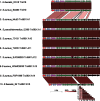Staphylococci on ICE: Overlooked agents of horizontal gene transfer
- PMID: 28932624
- PMCID: PMC5599092
- DOI: 10.1080/2159256X.2017.1368433
Staphylococci on ICE: Overlooked agents of horizontal gene transfer
Abstract
Horizontal gene transfer plays a significant role in spreading antimicrobial resistance and virulence genes throughout the genus Staphylococcus, which includes species of clinical relevance to humans and animals. While phages and plasmids are the most well-studied agents of horizontal gene transfer in staphylococci, the contribution of integrative conjugative elements (ICEs) has been mostly overlooked. Experimental work demonstrating the activity of ICEs in staphylococci remained frozen for years after initial work in the 1980s that showed Tn916 was capable of transfer from Enterococcus to Staphylococcus. However, recent work has begun to thaw this field. To date, 2 families of ICEs have been identified among staphylococci - Tn916 that includes the Tn5801 subfamily, and ICE6013 that includes at least 7 subfamilies. Both Tn5801 and ICE6013 commonly occur in clinical strains of S. aureus. Tn5801 is the most studied of the Tn916 family elements in staphylococci and encodes tetracycline resistance and a protein that, when expressed in Escherichia coli, inhibits restriction barriers to incoming DNA. ICE6013 is among the shortest known ICEs, but it still includes many uncharacterized open reading frames. This element uses an IS30-like transposase as its recombinase, providing some versatility in integration sites. ICE6013 also conjugatively transfers among receptive S. aureus strains at relatively higher frequency than Tn5801. Continued study of these mobile genetic elements may reveal the full extent to which ICEs impact horizontal gene transfer and the evolution of staphylococci.
Keywords: ICE6013; Staphylococcus aureus; Tn5801; Tn916; conjugation; horizontal gene transfer; integrative conjugative elements.
Figures


Similar articles
-
Transposase-Mediated Excision, Conjugative Transfer, and Diversity of ICE6013 Elements in Staphylococcus aureus.J Bacteriol. 2017 Mar 28;199(8):e00629-16. doi: 10.1128/JB.00629-16. Print 2017 Apr 15. J Bacteriol. 2017. PMID: 28138100 Free PMC article.
-
Sequence-Based Characterization of Tn5801-Like Genomic Islands in Tetracycline-Resistant Staphylococcus pseudintermedius and Other Gram-positive Bacteria from Humans and Animals.Front Microbiol. 2016 Apr 26;7:576. doi: 10.3389/fmicb.2016.00576. eCollection 2016. Front Microbiol. 2016. PMID: 27199912 Free PMC article.
-
Diversity of the tetracycline resistance gene tet(M) and identification of Tn916- and Tn5801-like (Tn6014) transposons in Staphylococcus aureus from humans and animals.J Antimicrob Chemother. 2009 Sep;64(3):490-500. doi: 10.1093/jac/dkp214. Epub 2009 Jun 16. J Antimicrob Chemother. 2009. PMID: 19531603
-
Integrative and Conjugative Elements (ICEs): What They Do and How They Work.Annu Rev Genet. 2015;49:577-601. doi: 10.1146/annurev-genet-112414-055018. Epub 2015 Oct 14. Annu Rev Genet. 2015. PMID: 26473380 Free PMC article. Review.
-
Evolutionary persistence of tripartite integrative and conjugative elements.Plasmid. 2017 Jul;92:30-36. doi: 10.1016/j.plasmid.2017.06.001. Epub 2017 Jun 29. Plasmid. 2017. PMID: 28669811 Review.
Cited by
-
Antibiotic Resistance-Susceptibility Profiles of Enterococcus faecalis and Streptococcus spp. From the Human Vagina, and Genome Analysis of the Genetic Basis of Intrinsic and Acquired Resistances.Front Microbiol. 2020 Jun 26;11:1438. doi: 10.3389/fmicb.2020.01438. eCollection 2020. Front Microbiol. 2020. PMID: 32695087 Free PMC article.
-
Genetic determinants of macrolide and tetracycline resistance in penicillin non-susceptible Streptococcus pneumoniae isolates from people living with HIV in Dar es Salaam, Tanzania.Ann Clin Microbiol Antimicrob. 2023 Feb 20;22(1):16. doi: 10.1186/s12941-023-00565-3. Ann Clin Microbiol Antimicrob. 2023. PMID: 36803640 Free PMC article. Clinical Trial.
-
Activation of the integrative and conjugative element Tn916 causes growth arrest and death of host bacteria.PLoS Genet. 2022 Oct 24;18(10):e1010467. doi: 10.1371/journal.pgen.1010467. eCollection 2022 Oct. PLoS Genet. 2022. PMID: 36279314 Free PMC article.
-
Environmental Galenics: large-scale fortification of extant microbiomes with engineered bioremediation agents.Philos Trans R Soc Lond B Biol Sci. 2022 Aug 15;377(1857):20210395. doi: 10.1098/rstb.2021.0395. Epub 2022 Jun 27. Philos Trans R Soc Lond B Biol Sci. 2022. PMID: 35757882 Free PMC article. Review.
-
Virulence factor landscape of a Staphylococcus aureus sequence type 45 strain, MCRF184.BMC Genomics. 2019 Feb 8;20(1):123. doi: 10.1186/s12864-018-5394-2. BMC Genomics. 2019. PMID: 30736742 Free PMC article.
References
Publication types
Grants and funding
LinkOut - more resources
Full Text Sources
Other Literature Sources
